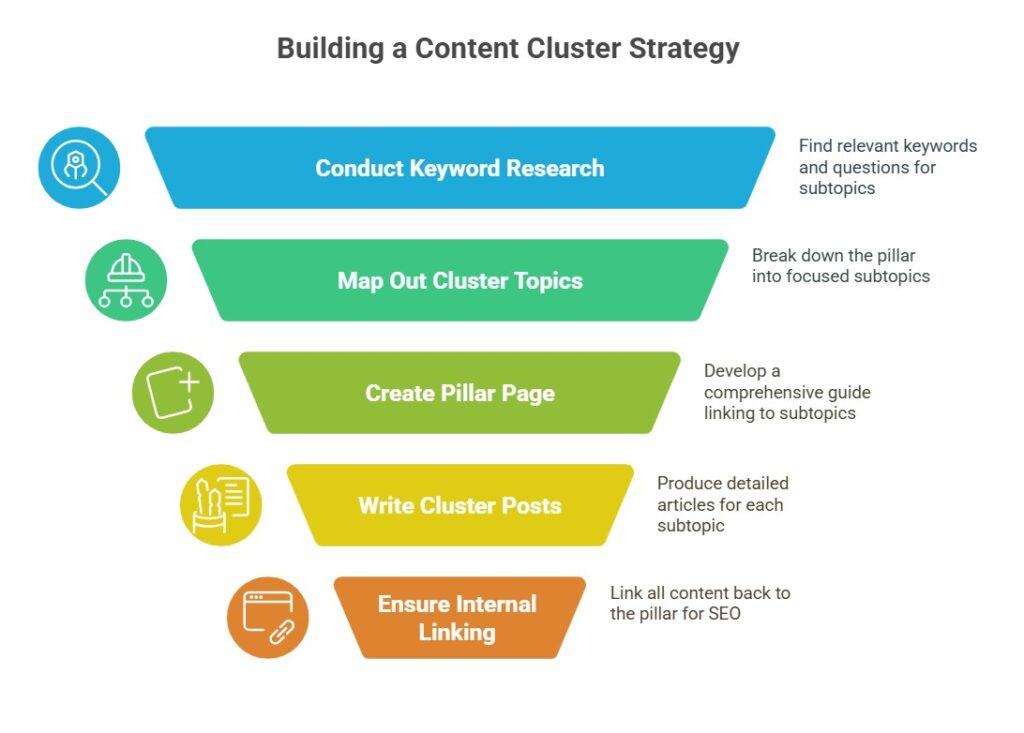
Table of Contents
- Introduction: Why the Traditional Blog Post Strategy Is No Longer Enough
- The Rise of the Content Cluster Model
- How Search Behavior Has Changed
- Pillar Pages vs. Blog Posts: What’s the Difference?
- Building Your First Content Cluster: Step-by-Step
- Optimizing for SEO and User Intent
- Common Pitfalls and How to Avoid Them
- Measuring the Impact of Your Cluster Strategy
- Future-Proofing Your Content Strategy
- Conclusion: Moving from Chaos to Cohesion
Introduction: Why the Traditional Blog Post Strategy Is No Longer Enough
For years, digital marketers and content creators followed a familiar playbook—create blog posts around specific keywords and hope to rank high on Google. While this worked in the early 2010s, search engines and user behavior have evolved significantly. The single-keyword, single-post method no longer drives sustainable traffic or rankings in a highly competitive digital space. Content has become more fragmented, and without a structured strategy, even high-quality posts get lost in the noise. Today, to capture and retain attention, content needs to be part of a broader, more connected system. Enter the content cluster model—a strategy that emphasizes relevance, structure, and long-term authority building.
The Rise of the Content Cluster Model
The content cluster model emerged as a response to the inefficiencies of disconnected blogging. Instead of standalone posts, marketers now create clusters of interlinked content centered around a comprehensive “pillar page.” This model is rooted in semantic search and topic authority, aligning with how search engines like Google understand and prioritize content. Clusters signal depth and breadth on a subject, enhancing a website’s credibility and improving internal linking. The result is a cohesive library of content that performs better in rankings, improves user navigation, and enhances the user experience. It’s not just about more content—it’s about smarter content that works together.
How Search Behavior Has Changed
Search engines no longer rely solely on matching exact keywords; they understand context, intent, and the relationship between topics. Users, too, have changed how they search. They ask detailed questions, use voice search, and expect immediate, relevant answers. This means that surface-level blog posts targeting vague keywords won’t cut it anymore. Google’s algorithms now favor comprehensive, interconnected content ecosystems that demonstrate topical expertise. If your content doesn’t reflect this structure, it’s less likely to rank well. Understanding user intent and creating clusters around their queries allows brands to meet them where they are—whether they’re learning, comparing, or deciding to buy.
Pillar Pages vs. Blog Posts: What’s the Difference?
A pillar page serves as the authoritative source on a broad topic and links out to more detailed subtopics (cluster content). Think of it as a hub, with blog posts acting as spokes that go deeper into specific areas. For example, a pillar page on “Content Marketing Strategy” might link to detailed posts about SEO, content calendars, buyer personas, and social media distribution. Unlike traditional blog posts, pillar pages are long-form, evergreen, and designed to rank for competitive keywords. Their strategic value lies in how they organize and distribute authority across your website, guiding both users and search engines through your content.
Building Your First Content Cluster: Step-by-Step
To build a content cluster, start by identifying a broad topic relevant to your business goals and audience needs. This becomes your pillar. Next, perform keyword research to discover subtopics and related questions people ask. These subtopics will become your cluster posts. Create a long, comprehensive pillar page that touches on each of these areas and links to the individual blog posts. Each blog post, in turn, should link back to the pillar. This interlinking creates a semantic structure that search engines love.
Here’s a step-by-step approach to building your first content cluster:

- Choose a Core Topic (Pillar): Select a broad subject that aligns with your expertise and your audience’s interests (e.g., “Remote Work Strategies” or “Content Marketing”).
- Conduct Keyword Research: Use tools like SEMrush, Ahrefs, or Ubersuggest to find long-tail keywords and related questions users are searching for.
- Map Out Cluster Topics: Break the pillar topic into smaller, focused articles (e.g., “How to Stay Productive While Working Remotely,” “Tools for Remote Teams,” etc.).
- Create the Pillar Page: Write a comprehensive guide that briefly introduces each subtopic and links out to the cluster posts.
- Write Cluster Posts: Develop detailed articles for each subtopic, ensuring they’re internally linked back to the pillar.
- Ensure Internal Linking: All cluster content should link to and from the pillar page for maximum SEO benefit.
- Publish and Promote: Roll out the content across your blog and promote it through social media, email, and other channels.
Use a content calendar to track your progress and ensure consistency. The cluster approach is a long-term investment that builds authority over time, so patience and strategic planning are essential.
Optimizing for SEO and User Intent
Optimization in a cluster strategy goes beyond basic on-page SEO. It involves structuring your content so it answers user intent at every stage of the buyer’s journey. Use schema markup, well-organized headers, internal linking, and rich media to enhance content quality. Pay attention to related queries, people-also-ask sections, and featured snippet opportunities. Each blog post should serve a distinct purpose: educating, solving a problem, or offering insight. The pillar page should guide users through a logical flow, offering access to deeper knowledge via linked cluster posts. Regularly update and re-optimize content based on performance data to stay competitive.
Common Pitfalls and How to Avoid Them
Many businesses make the mistake of launching content clusters without a cohesive strategy. One common error is choosing too broad or too narrow a pillar topic. Others produce cluster posts that don’t genuinely add value or fail to link them properly. This results in a disjointed experience for users and missed opportunities for SEO. Another issue is publishing too many clusters at once without sufficient quality control, leading to diluted authority. The key is to prioritize quality over quantity. Start small, build one high-quality cluster at a time, and monitor performance before scaling. Consistency and strategy always win over content sprawl.
Measuring the Impact of Your Cluster Strategy
Success in content marketing is measured not just by traffic, but by engagement, lead generation, and conversions. Use tools like Google Analytics, Google Search Console, and HubSpot to track the performance of your content clusters. Monitor metrics such as average session duration, bounce rate, keyword rankings, and the number of internal clicks between cluster content. Analyze how users move through your site—from the pillar to blog posts and back—and whether this journey aligns with your conversion goals. Content clusters often have a compounding effect, so measure progress over time. A well-executed cluster can drive results long after it’s published.
Future-Proofing Your Content Strategy
The digital landscape continues to evolve with advancements in AI, voice search, and personalized content experiences. To future-proof your strategy, ensure your clusters are adaptable. Regularly update your pillar and cluster content with new data, examples, and best practices. Embrace multimedia—videos, infographics, podcasts—to enrich your pages. Consider using AI tools to analyze gaps, optimize for voice queries, or even generate first drafts. Keep an eye on algorithm updates and shift your approach as needed. The content cluster model is designed to be flexible and scalable, which makes it one of the most future-resilient frameworks in digital marketing today.
Conclusion: Moving from Chaos to Cohesion
The transition from scattered blog posts to structured content clusters marks a maturity in how brands approach digital content. It’s not just about creating more—it’s about creating better, more connected, and more purposeful content. Clusters bring order to chaos, boost SEO, enhance user experience, and position your brand as a thought leader in your niche. While the shift may require rethinking your content workflow, the long-term payoff in visibility, authority, and leads makes it worth the effort. As the digital ecosystem grows more complex, having a structured, user-focused content strategy is no longer optional—it’s essential.
FAQs
1. What is a content cluster in digital marketing?
A content cluster is a group of interlinked web pages built around one central topic (the pillar page) and related subtopics (cluster content), designed to improve SEO and user experience.
2. How do I choose a topic for my pillar page?
Choose a broad, high-level topic relevant to your audience and business. It should be something you want to be known for and that allows for multiple in-depth subtopics.
3. Do I need to rewrite my existing blog posts to fit the cluster model?
Not necessarily. You can often repurpose existing content by updating it and linking it to a new or existing pillar page, creating structure without starting from scratch.
4. How many blog posts should be in a content cluster?
There’s no fixed number, but a good starting point is 5–10 high-quality posts around one pillar topic. The focus should be on depth and relevance, not quantity alone.
5. Can content clusters help with lead generation?
Yes. Content clusters guide users through the buyer journey and position your brand as an authority, increasing trust and driving more qualified leads over time.




